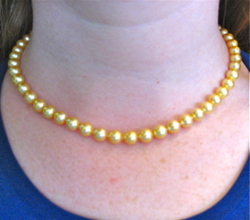
Since pearl is the June birthstone, I figured I’d write about how salt water cultured pearls are made.
Cultured pearls are an extraordinary collaboration between man and mollusk; that is to say, man has helped the oysters produce pearls. The Japanese have been culturing pearls since the 1880’s starting with mabe pearls, which are grown against the shell, and then in the 20th century with round cultured pearls. The process that produces a salt water cultured pearl is a long and involved one, but it clearly demonstrates the value of this beautiful gem.
Baby oysters, called spat, are farmed to a certain age. They start off as a thread -like larva, which will eventually cling to a surface and start to build a shell. Then they are placed in cages and submersed into the sea. They are fed with tubes near the cages and cleaned every three weeks to get rid of barnacles. The pearl farmers must also move the oysters periodically to avoid temperature changes and red tides, a problem caused by pollution.
When they are three years old the oysters are nucleated with a piece of shell, usually from a mollusk found in the Mississippi River, that is sent to Japan and cut into different size spheres. The pearl farmers use a donor oyster for the mantle tissue, the part of the oyster that makes a pearl. They cut this tissue into cubes and surgically implant it with the shell nucleus into other oysters' feet or gonads. This surgical process must be carried out within twenty minutes of taking the tissue. The shell color of the donor oyster determines the color of the pearl. The oyster then deposits calcium carbonate in the form of nacre, the shiny surface, onto the shell bead, just like a wild oyster would coat an irritant. Up to three pearls may be grown in one oyster, although better pearls are produced when only one is grown in an oyster.
Again the farmers place the oysters in cages and submerse them into the sea, where they are fed, cleaned and moved for one to three years. One in three oysters will die and only one in four will produce a pearl.
At the end of the growing process, the farmers open the oysters and remove the pearls. The cultured pearls are then sorted by size, color, roundness, and surface complexion. It takes sorting through 10,000 pearls to make one eighteen-inch necklace. The pearls are drilled and strung on “hanks” and are sold to stringers who string them on silk with a clasp.
And thus, man’s collaboration with nature truly produces a jewel of the sea.


